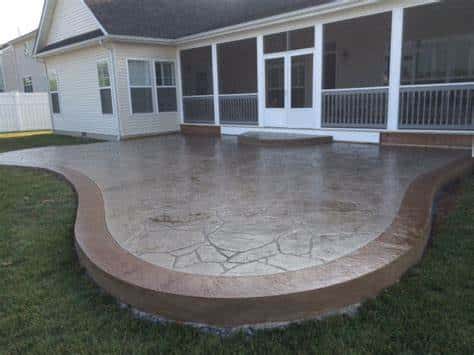Why Sealing Stamped Concrete Is Necessary To Prevent Cracks In Imperial Beach?

- One of the primary benefits of sealing stamped concrete is its ability to withstand the harsh effects of weather. Rain, snow, and extreme temperatures can all cause the concrete to expand and contract, leading to cracks. A sealant acts as a barrier against moisture and temperature changes, reducing the risk of weather-related cracking.
- Stamped concrete often contains color additives that can fade over time when exposed to UV rays from the sun. Sealing the concrete helps protect these pigments, maintaining the vibrant color and finish of the surface for a longer period.
- Unsealed stamped concrete is porous and can absorb spills, leading to unsightly stains. Sealing the surface creates a non-porous layer that resists oil, grease, and other common stain-inducing substances, making it easier to clean and maintain.
- Sealing stamped concrete increases its resistance to wear and tear. Foot traffic, vehicle load, and abrasive materials can erode the surface over time. A sealant reduces surface abrasion, thereby preventing the formation of small cracks that can grow into larger ones.
- Efflorescence, the white powdery residue that can appear on concrete, is caused by water moving through the material and carrying minerals to the surface. Sealing stamped concrete helps to prevent water absorption, thus minimizing the risk of efflorescence and associated cracking.
- By sealing stamped concrete, you prevent water and organic matter from settling in the crevices. This helps to inhibit the growth of mold, mildew, and weeds, which can all lead to or exacerbate cracking if they expand within the concrete.
- Although sealing stamped concrete represents an upfront cost, it can result in significant savings over time. By preventing cracks and other forms of damage, sealing minimizes the need for repairs or premature replacement, offering long-term financial benefits.
FAQs
How Often Should Stamped Concrete Be Sealed?
Stamped concrete should typically be resealed every 2 to 3 years, depending on the level of exposure to traffic, weather, and chemicals. Regular inspections can help determine when a new coat of sealant is necessary.
Can Sealing Stamped Concrete Prevent All Types Of Cracks?
While sealing greatly reduces the risk of surface cracks, it cannot prevent all types of cracking. Issues like structural settlement or improper installation can lead to cracks that surface sealing may not address.
Does Sealing Stamped Concrete Make It Slippery?
Some sealants can make stamped concrete more slippery, especially when wet. However, additives can be mixed into the sealant to provide a non-slip surface while still protecting the concrete from cracks.
Conclusion
Sealing stamped concrete is not merely a cosmetic or optional choice—it’s a preventive measure to maintain the integrity and appearance of the concrete. The reasons to seal range from protecting against weathering to enhancing durability, and ultimately lead to long-term cost savings. While sealing cannot prevent every possible crack or damage to the concrete, it significantly reduces the risk and prolongs the life of the surface. Regular sealing, coupled with proper installation and maintenance, can keep stamped concrete looking pristine and crack-free for years to come. For more information, contact Concrete Contractor Imperial Beach at (619) 414-1918.